Laravel 11 Flash Message Example Tutorial
In this example, I would like to show you how to add flash messages in Laravel 11 application. We will use Bootstrap 5 alert for flash messages like success, error, warning, and info.
We will define various types of flash message notifications like alert-success, alert-danger, alert-info, and alert-warning messages in Bootstrap Laravel 11 projects. When you have a successful task on the controller method, you can use a success flash message; if you encounter any error task, you can use an error flash message.
Flash messages are required in Laravel 11 application because that way we can give alerts regarding what progress is complete, error, warning, etc. In this tutorial, I will cover several ways to give a flash message, such as redirecting with a success message, redirecting with an error message, redirecting with a warning message, and redirecting with an info message. In this example, we use a Bootstrap flash alert layout, which enhances the overall layout.
So, you just have to follow the basic three steps to integrate flash messages into your Laravel 11 application. Let's follow the steps below:
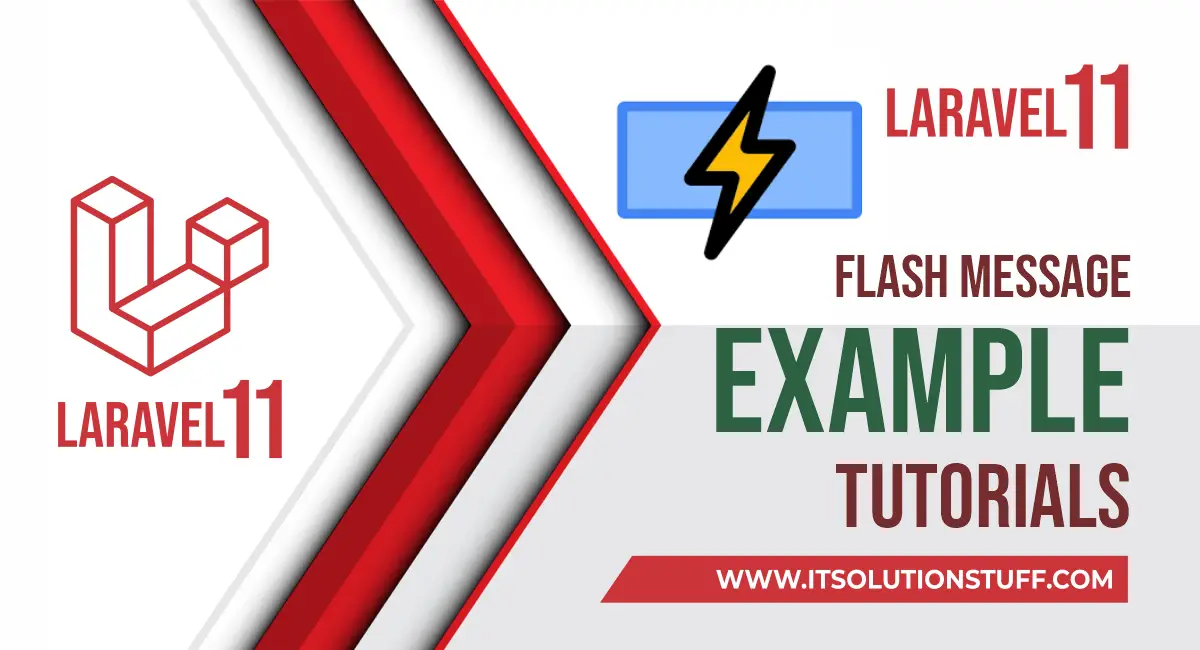
Step 1: Create Global File For Flash Message
In the first step, we will create a new Blade file flash-messages.blade.php. In this file, we will write the code for Bootstrap alert and check which messages come.
The following alerts will be added:
1)success
2)error
3)warning
4)info
5)validation error
So, let's create flash-messages.blade.php file and put the below code on that file.
resources/views/layouts/flash-messages.blade.php
@session('success')
<div class="alert alert-success alert-dismissible fade show" role="alert">
{{ $value }}
<button type="button" class="btn-close" data-bs-dismiss="alert" aria-label="Close"></button>
</div>
@endsession
@session('error')
<div class="alert alert-danger alert-dismissible fade show" role="alert">
{{ $value }}
<button type="button" class="btn-close" data-bs-dismiss="alert" aria-label="Close"></button>
</div>
@endsession
@session('warning')
<div class="alert alert-warning alert-dismissible fade show" role="alert">
{{ $value }}
<button type="button" class="btn-close" data-bs-dismiss="alert" aria-label="Close"></button>
</div>
@endsession
@session('info')
<div class="alert alert-info alert-dismissible fade show" role="alert">
{{ $value }}
<button type="button" class="btn-close" data-bs-dismiss="alert" aria-label="Close"></button>
</div>
@endsession
@if ($errors->any())
<div class="alert alert-danger alert-dismissible fade show" role="alert">
<strong>Please check the form below for errors</strong>
<button type="button" class="btn-close" data-bs-dismiss="alert" aria-label="Close"></button>
</div>
@endif
Step 2: Use Flash Message in Theme
In this step, we have to include the flash-messages.blade.php file in your theme's default file. You just have to include this flash file in your default theme blade file as below:
@include('flash-messages')You can also see I added a flash file to my theme, so you can add it that way. Let's see below example:
resources/views/layouts/app.blade.php
<!doctype html>
<html lang="{{ str_replace('_', '-', app()->getLocale()) }}">
<head>
<meta charset="utf-8">
<meta name="viewport" content="width=device-width, initial-scale=1">
<!-- CSRF Token -->
<meta name="csrf-token" content="{{ csrf_token() }}">
<title>{{ config('app.name', 'Laravel') }}</title>
<!-- Fonts -->
<link rel="dns-prefetch" href="//fonts.bunny.net">
<link href="https://fonts.bunny.net/css?family=Nunito" rel="stylesheet">
<!-- Scripts -->
@vite(['resources/sass/app.scss', 'resources/js/app.js'])
</head>
<body>
<div id="app">
<nav class="navbar navbar-expand-md navbar-light bg-white shadow-sm">
<div class="container">
<a class="navbar-brand" href="{{ url('/') }}">
{{ config('app.name', 'Laravel') }}
</a>
<button class="navbar-toggler" type="button" data-bs-toggle="collapse" data-bs-target="#navbarSupportedContent" aria-controls="navbarSupportedContent" aria-expanded="false" aria-label="{{ __('Toggle navigation') }}">
<span class="navbar-toggler-icon"></span>
</button>
<div class="collapse navbar-collapse" id="navbarSupportedContent">
<!-- Left Side Of Navbar -->
<ul class="navbar-nav me-auto">
</ul>
...
</div>
</div>
</nav>
<main class="py-4">
@include('layouts.flash-messages')
@yield('content')
</main>
</div>
</body>
</html>
Step 3: Use Flash Messages with Redirect
In this step, we will learn how to give a message when you redirect one by one.
1. Redirect with success message
We can simply redirect a route or redirect a URL or redirect back with a success flash message. We can use it in the controller like this:
<?php
namespace App\Http\Controllers;
use Illuminate\Http\Request;
use App\Models\User;
class UserController extends Controller
{
/**
* Display a listing of the resource.
*
* @return \Illuminate\Http\Response
*/
public function store()
{
$this->validate($request,[
'name' => 'required',
'email' => 'required',
'password' => 'required'
]);
$user = User::create($request->all());
return back()->with('success', 'User created successfully!');
}
}
You can get layout of success flash message:
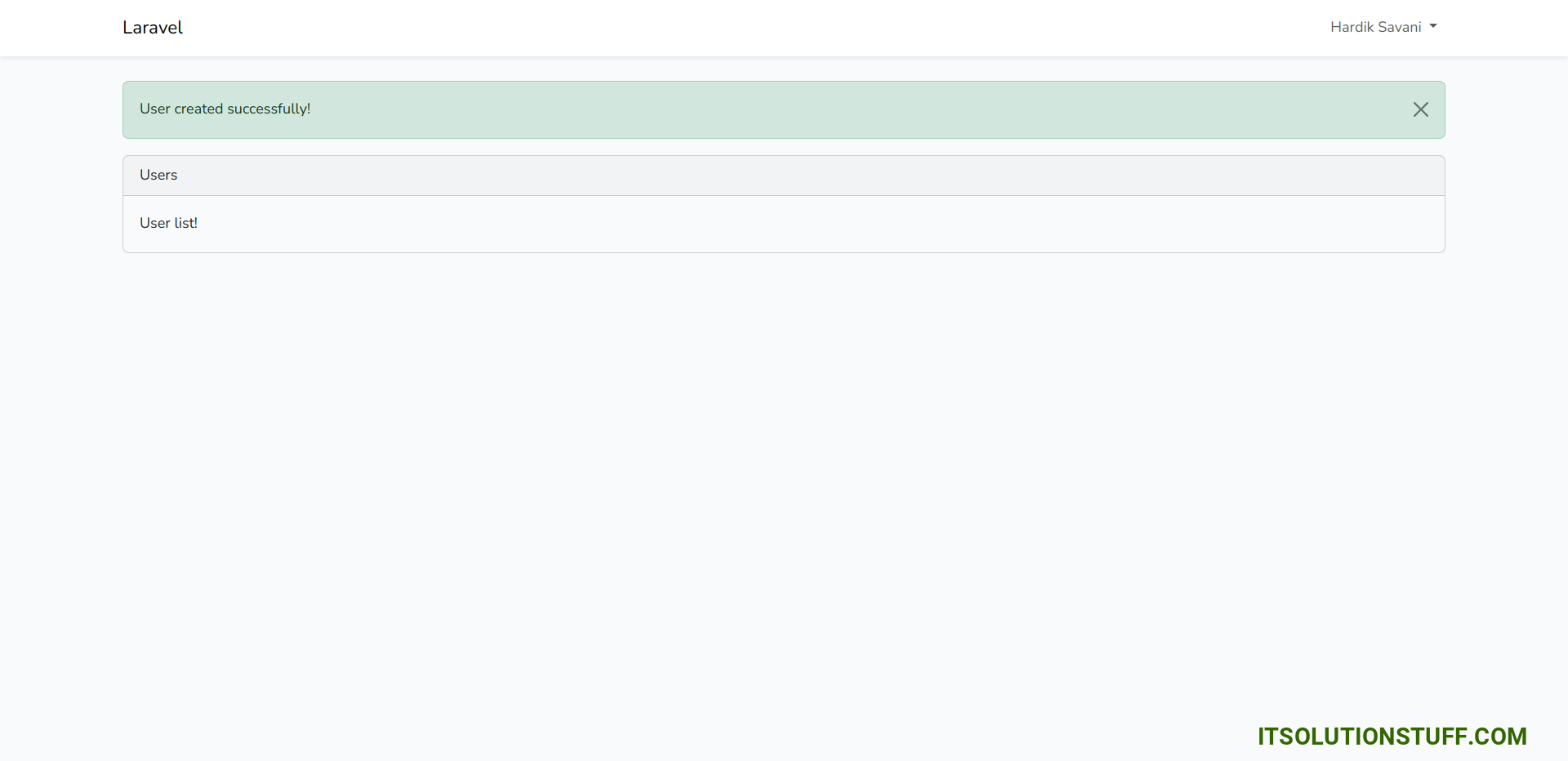
2. Redirect with error message
We can simply redirect the route or redirect the URL or redirect back with an error flash message. We can use it in the controller like this:
<?php
namespace App\Http\Controllers;
use Illuminate\Http\Request;
class UserController extends Controller
{
/**
* Display a listing of the resource.
*
* @return \Illuminate\Http\Response
*/
public function index()
{
return redirect()->route('home')
->with('error', 'Something is wrong!');
}
}
You can get layout of error flash message:
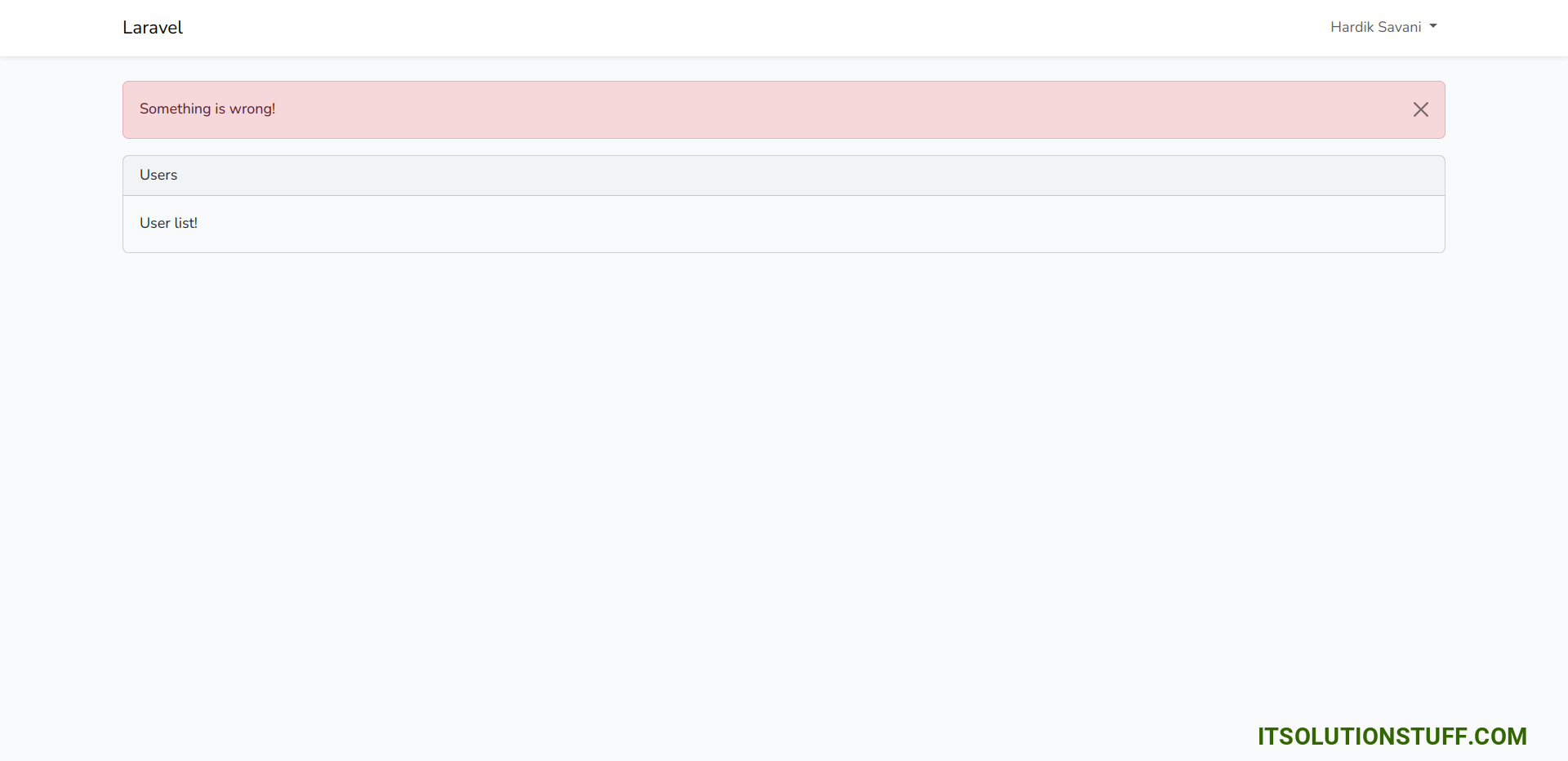
3. Redirect with warning message
We can simply redirect the route or redirect the URL or redirect back with a warning flash message. We can use it in the controller like this:
<?php
namespace App\Http\Controllers;
use Illuminate\Http\Request;
class UserController extends Controller
{
/**
* Display a listing of the resource.
*
* @return \Illuminate\Http\Response
*/
public function index()
{
return redirect()->route('home')
->with('warning', 'User email required!');
}
}
You can get layout of warning flash message:
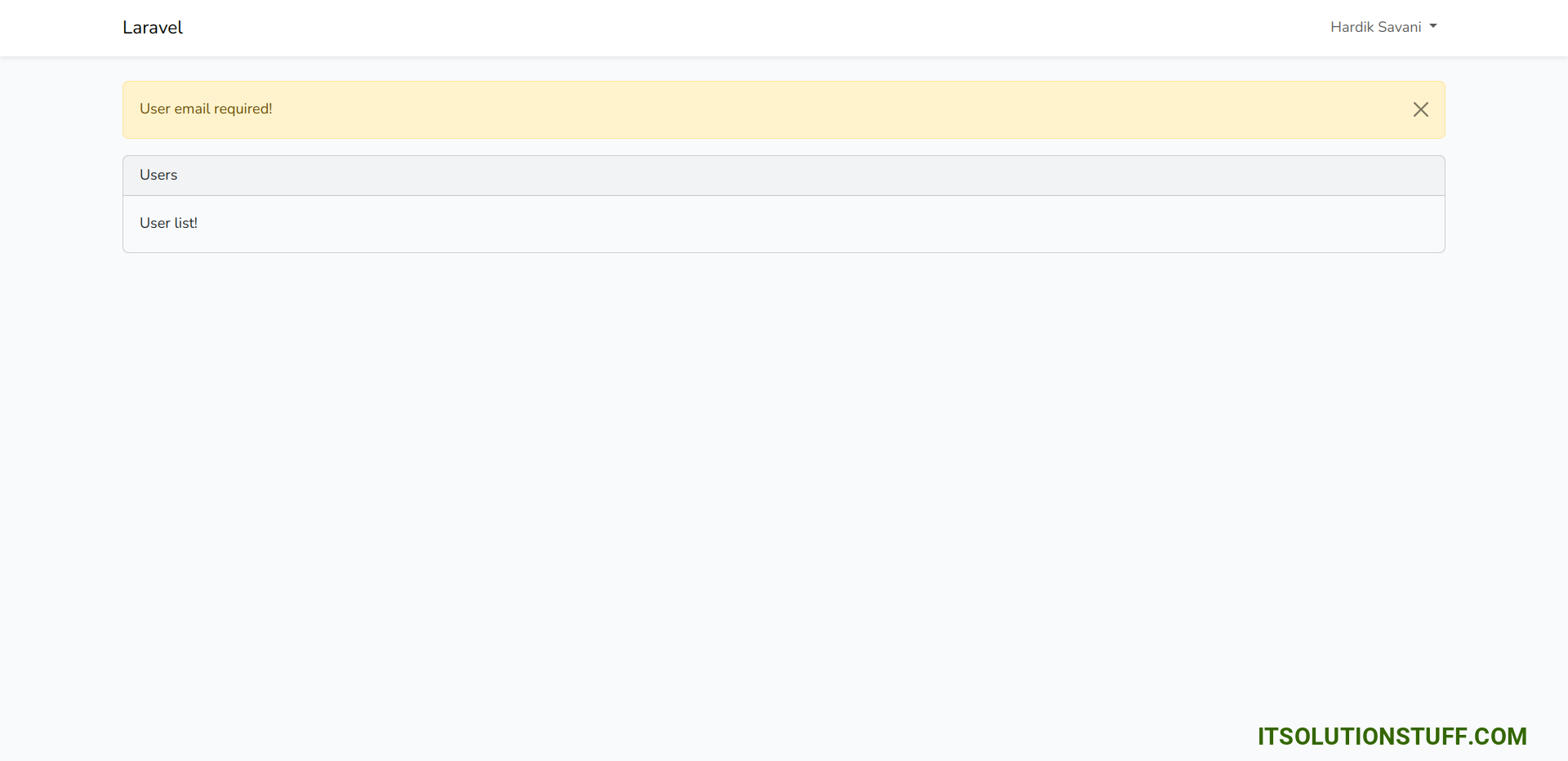
4. Redirect with info message
We can simple redirect route or redirect url or redirect back with info flash message, we can use in controller like this way:
<?php
namespace App\Http\Controllers;
use Illuminate\Http\Request;
class UserController extends Controller
{
/**
* Display a listing of the resource.
*
* @return \Illuminate\Http\Response
*/
public function index()
{
return redirect()->route('home')
->with('info', 'User fetched successfully!');
}
}
You can get layout of info flash message:
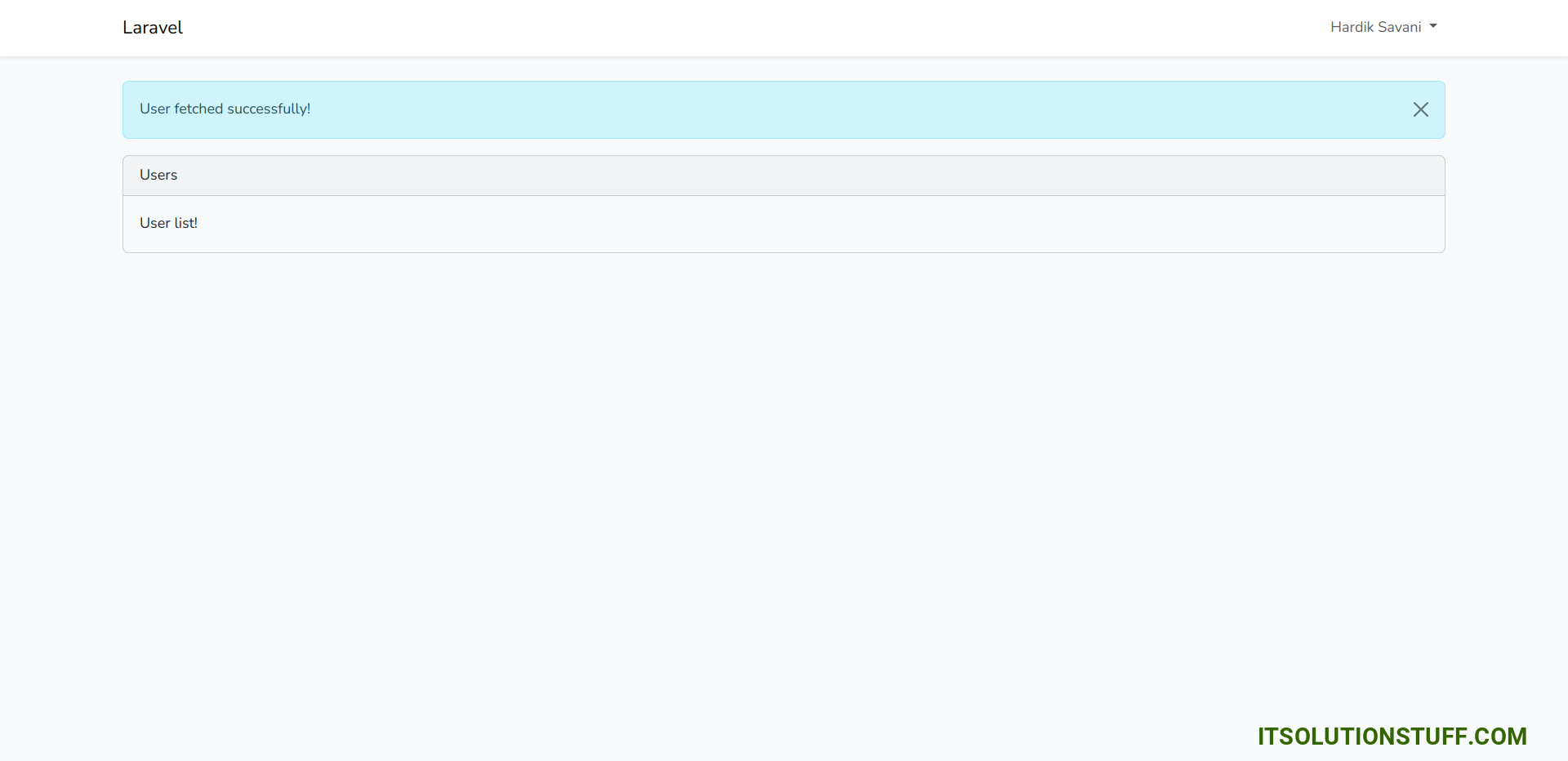
5. Validation Error
If you use laravel 5 validation then you will redirect back with errors automatically, At that time it will also generate error flash message.
<?php
namespace App\Http\Controllers;
use Illuminate\Http\Request;
class UserController extends Controller
{
/**
* Display a listing of the resource.
*
* @return \Illuminate\Http\Response
*/
public function store()
{
$this->validate($request,[
'name' => 'required',
'email' => 'required',
'password' => 'required'
]);
...
}
}
You can get layout of error flash message:
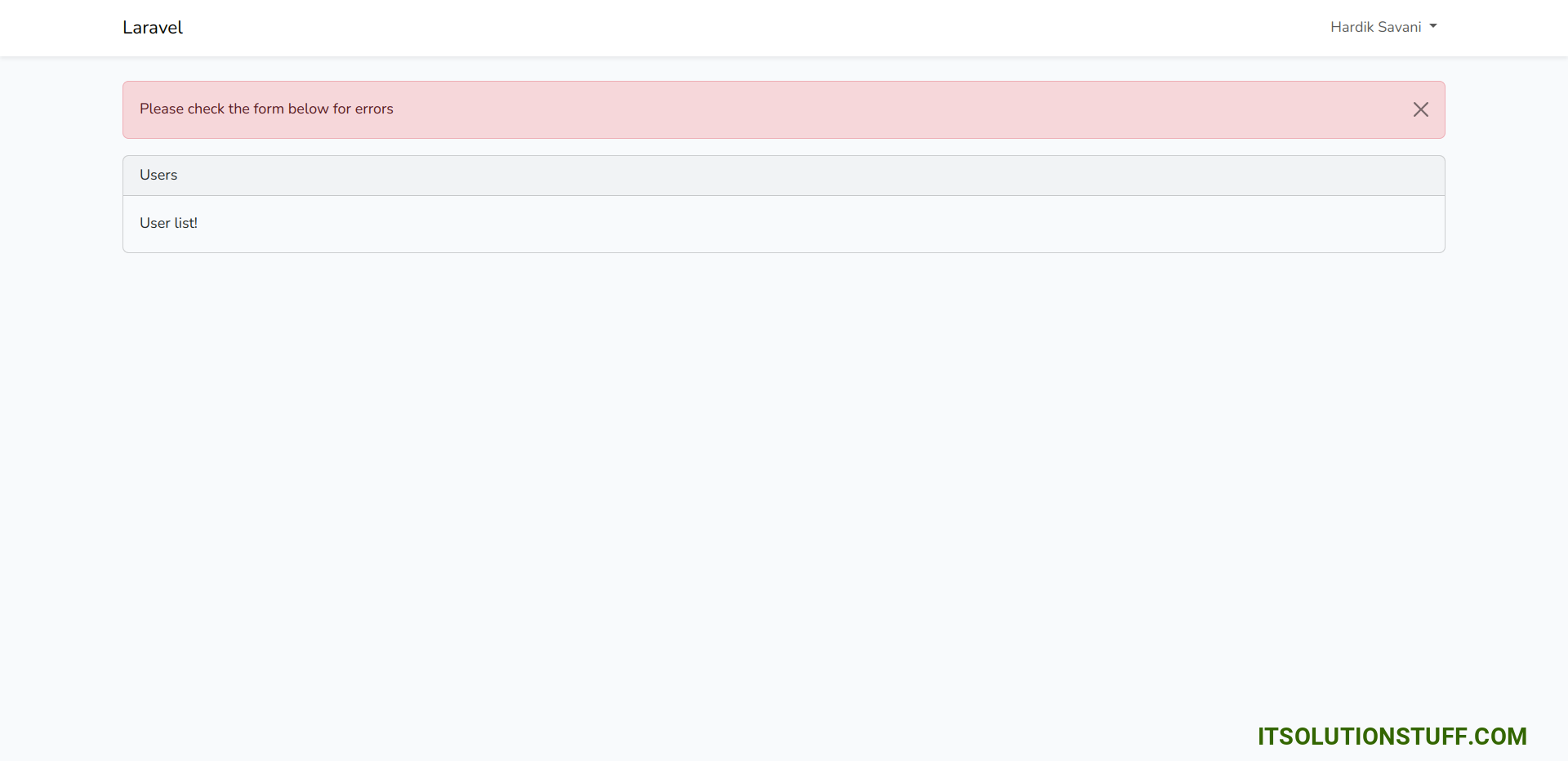
This way you can simple implement flash message in your laravel 11 application.
I hope it can help you....

